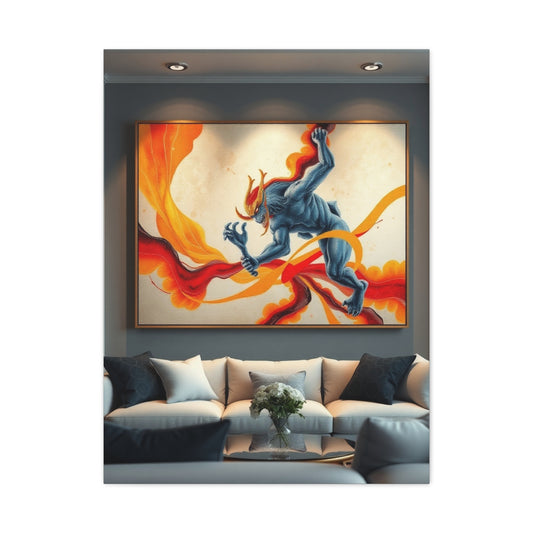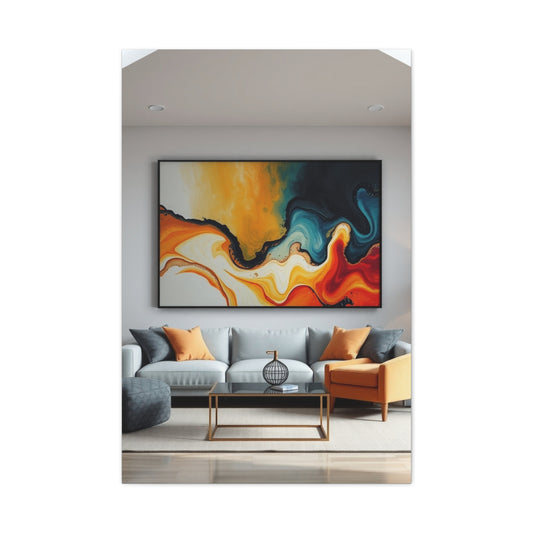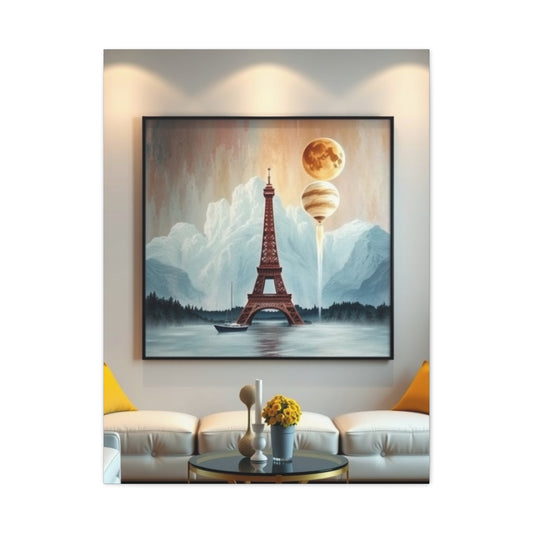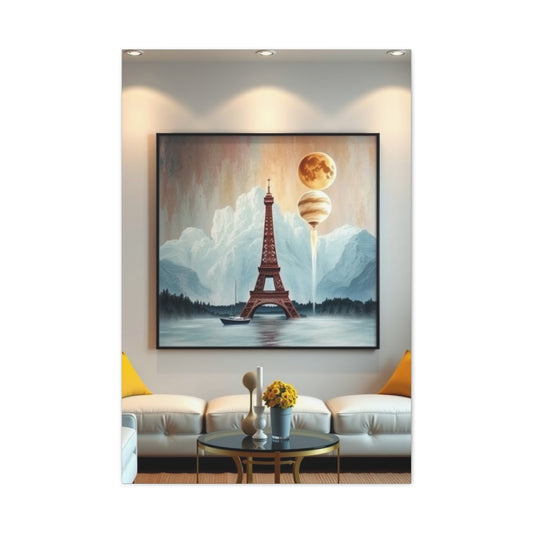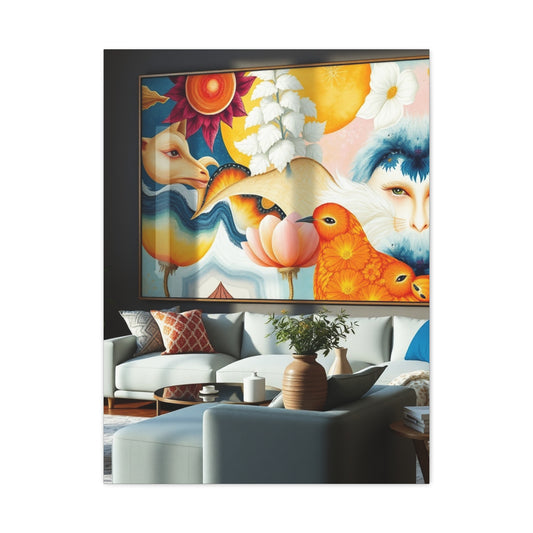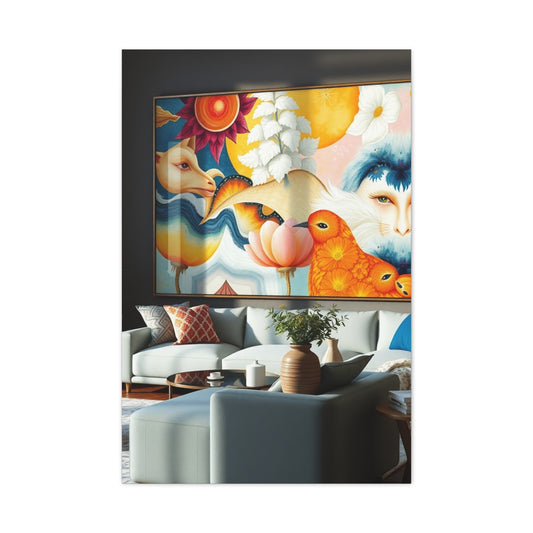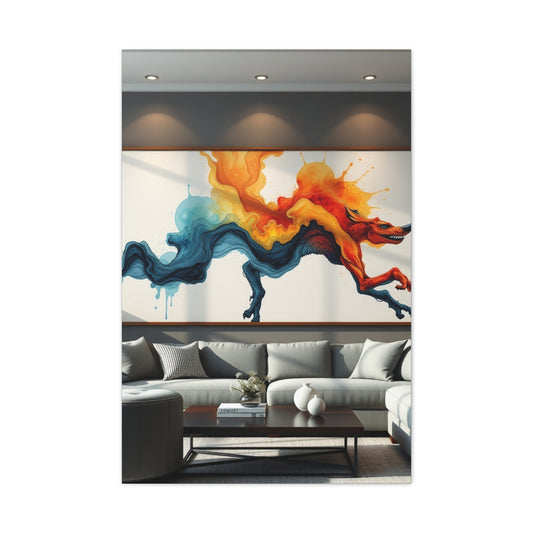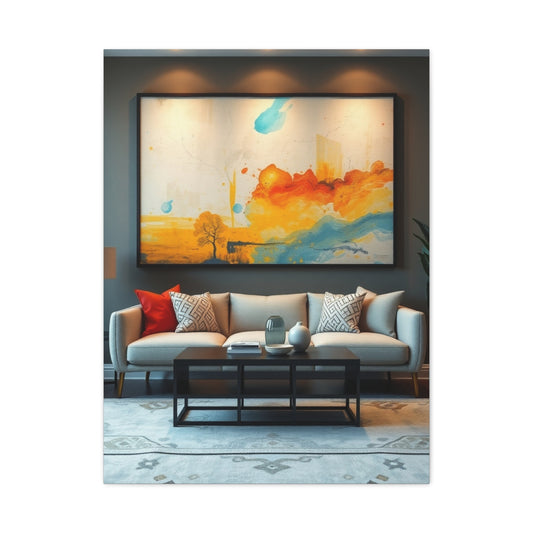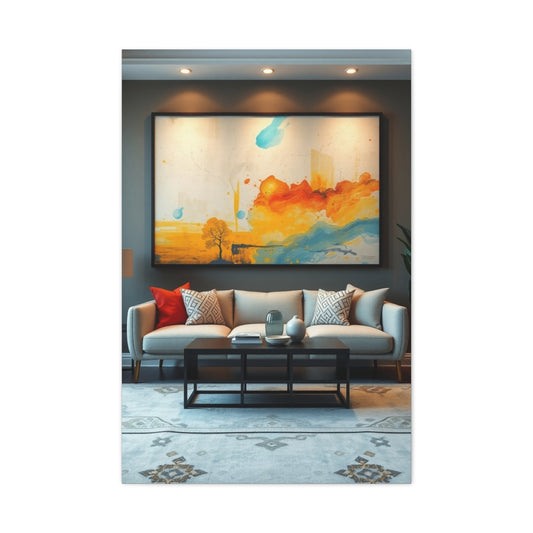Blank walls can make even the most stylish rooms feel incomplete. They often lack the personality and emotional resonance that transforms a house into a home. The good news is that wall art provides one of the most versatile, affordable, and meaningful ways to breathe life into your interiors. Whether you're inclined toward vibrant abstract canvases or subtle, minimalist prints, the art you choose can reflect your unique identity while enhancing the overall design of your home. This comprehensive guide explores how to bring every room to life with the right wall decor.
Creating a Peaceful Bedroom with Thoughtful Artwork
Your bedroom is far more than a place for sleep—it is your sanctuary, your personal refuge from the noise and demands of daily life. It should be a space that brings you peace, promotes restfulness, and provides an intimate canvas for self-expression. Among the many elements that contribute to a bedroom’s mood and function, wall art holds a special ability to evoke emotion and elevate ambiance. By carefully curating art in your bedroom, you not only beautify your surroundings but also foster a restorative, emotionally grounded environment.
Making a Statement Above the Headboard
The wall behind your bed is prime real estate for creative expression. As the visual centerpiece of the room, it offers a powerful opportunity to establish the tone and energy of your entire bedroom. A thoughtfully chosen large-scale artwork above the headboard anchors the space with purpose and personality.
Consider selecting a calming landscape—such as a misty forest, tranquil sea, or soft meadow. These natural scenes create a soothing effect, ideal for promoting restfulness. Alternatively, abstract pieces with gentle curves, muted tones, and flowing forms can evoke a sense of serenity and balance. The organic ambiguity of abstract art encourages relaxation and introspection, perfect for unwinding after a long day.
If your bedroom leans toward contemporary or modern design, a bold geometric or minimalist black-and-white composition can introduce striking contrast and structure. Be mindful of proportions—choose an artwork that spans about two-thirds the width of your bed to maintain visual harmony and prevent the piece from feeling either overwhelming or too diminutive.
Proper placement is key. Ideally, the center of the artwork should sit between 6 to 12 inches above the headboard, ensuring the piece feels connected to the bed without crowding the space. This balance creates a unified, grounded look that helps reinforce the peaceful atmosphere of the room.
|
Related Catagories: |
Personalizing with a Gallery Wall
For those who appreciate visual storytelling and a more eclectic aesthetic, a gallery wall can be a deeply meaningful and engaging alternative to a single statement piece. Gallery walls allow you to showcase a collection of prints, drawings, photographs, or mixed-media pieces that reflect your personality, values, and memories.
Start by choosing a central theme—this could be nature, travel, line art, architecture, or even emotionally resonant quotes. Maintaining consistency in your palette or frame style will bring a sense of cohesion, even if the content varies. For instance, using all white or light wood frames creates unity, while allowing diverse subjects to share the wall.
When arranging your pieces, don’t feel constrained by symmetry. Asymmetrical layouts often feel more organic and intimate. Vary your spacing slightly (1.5 to 3 inches apart) to avoid rigidity while still maintaining a thoughtful visual flow. For a dynamic design, mix vertical and horizontal formats or include objects like a woven hanging or a small wall mirror.
A gallery wall above a dresser, along a side wall, or even surrounding the window can add depth and dimension. Unlike fixed furniture or built-in design elements, a gallery wall can evolve. Swap out prints seasonally or rotate in new memories as your life unfolds—this living design element ensures your bedroom always reflects who you are now.
Blending Texture and Mediums
To enrich the sensory quality of your bedroom, consider introducing varied materials and three-dimensional pieces. Wall art does not need to be confined to traditional paper or canvas. Incorporating texture can dramatically affect the atmosphere of the room, making it feel warmer, more layered, and more personal.
Explore pieces made from woven fabric, macramé, or quilted textiles. These add a softness and warmth that complements the comfort of bedding and upholstered furniture. Sculptural wall decor, such as wood-carved panels, ceramic forms, or clay art tiles, contributes an earthy, grounded feel. If your bedroom includes natural materials like linen, rattan, or reclaimed wood, these textural artworks will blend seamlessly.
Framed botanical specimens, feather art, or even pressed flowers in glass can create a romantic, organic ambiance. Alternatively, for a modern edge, consider mixed-media artworks that combine metal, glass, or even recycled materials. These visually arresting pieces can serve as focal points while introducing a sophisticated, curated vibe.
Texture isn’t only about physical dimension—it also comes through in color and brushstroke. Choose pieces with layered paint, watercolor washes, or visible stroke work to create visual depth that interacts subtly with your bedroom lighting throughout the day.
Complementing Your Color Palette
Color in your bedroom should work in concert with your artwork, not in conflict. A cohesive palette nurtures tranquility and unity, allowing your eyes—and mind—to rest. To achieve this, consider both the dominant colors in your room and the emotional tone you want to evoke.
If your bedroom features cool-toned walls, such as dove grey, soft sage, or powder blue, choose artwork that echoes these hues or complements them with neighboring colors on the color wheel. Artwork in faded greens, watery blues, and earthy taupes creates a spa-like ambiance, ideal for relaxation.
Warm-toned rooms can benefit from sepia prints, blush pinks, rusts, or muted golds. These tones feel nurturing and enveloping, especially in rooms with lots of natural light. For neutral backdrops, soft black and white art creates elegant simplicity, while adding just a hint of drama.
You can also use artwork as a subtle tool to introduce contrast. If your walls and furnishings are monochromatic, a single piece of art in a rich complementary color—like emerald green, terracotta, or cobalt—can invigorate the room without disrupting its peaceful energy.
Take lighting into account. Natural light can change the way colors appear, especially in the morning versus evening. Try to view artwork in the room where it will be displayed before finalizing your selection to ensure the tones remain flattering in all lighting conditions.
Additional Tips for a Harmonious Bedroom Design
To further enhance the tranquil energy of your bedroom through art:
-
Avoid overly stimulating imagery. Art that is aggressive, chaotic, or overly busy may detract from your room’s ability to promote rest.
-
Balance symmetry and asymmetry. If you choose to display matching artworks above nightstands, maintain symmetry for a formal and calming look. If you prefer a more artistic, boho-chic vibe, stagger your art to add movement and softness.
-
Integrate plant life. Small wall-mounted planters or greenery interspersed with your artwork can introduce freshness and a connection to nature, helping reduce stress.
-
Consider scale. Small art in a large room may feel insignificant. Likewise, oversized art in a small space may feel overwhelming. Always consider the wall's dimensions and the sightlines from various points in the room.
Adding Character to the Bathroom with Stylish Decor
While bathrooms are often designed with functionality in mind, they are just as deserving of thoughtful decor as any other room in the house. Often overlooked, this space holds immense potential to surprise and delight through well-chosen wall art and design details. Whether you’re decorating a spacious master bath or a cozy powder room, incorporating the right wall decor can elevate the space from utilitarian to inspired. With a blend of creativity and purpose, wall art in the bathroom brings warmth, humor, elegance, or even drama, turning blank walls into canvases that enhance your daily routine.
Embracing Humor and Whimsy
Bathrooms provide a unique opportunity to showcase a playful side of your personality. Because this space is typically more private and separate from the rest of your home's design flow, it allows for experimentation. Humorous and whimsical wall art works particularly well here—offering charm, breaking up sterile visuals, and making guests feel instantly at ease.
Think of framed art with clever bathroom puns, vintage-inspired illustrations with cheeky captions, or cartoon-like graphics that nod playfully to hygiene or relaxation. Whether it's a line drawing of a quirky cat in a bathtub or a tongue-in-cheek quote like “Please Seat Yourself,” these pieces invite smiles and laughter. Typography prints with witty bathroom humor in sleek fonts can be both modern and fun, balancing silliness with aesthetic value.
The key to whimsical bathroom art is moderation. Choose one or two standout humorous pieces and position them strategically—above the toilet, by the vanity mirror, or opposite the shower. Keeping the rest of the decor simple ensures the playful art remains the focal point, not visual clutter.
Maintaining Simplicity with Minimalist Art
If your bathroom aesthetic leans toward serene or spa-inspired, minimalist artwork can amplify that tranquility without introducing unnecessary complexity. Minimalist wall art promotes clarity, balance, and calm—qualities that align beautifully with the functions of a bathroom.
Black-and-white photography offers timeless elegance and is especially effective in bathrooms with neutral color schemes or stone finishes. Subjects like quiet landscapes, soft textures, or abstract human forms evoke stillness and reflection. Abstract line art, often featuring simple outlines or single-stroke illustrations, can add artistic intrigue while maintaining visual restraint.
Soft watercolor prints with muted hues such as sage green, blush, or slate can add gentle color and subtle sophistication. When framed in natural wood or matte black, these pieces integrate seamlessly into modern, Scandinavian, or Japanese-inspired bathroom spaces.
Minimalist art also benefits from thoughtful placement. Consider a trio of small, evenly spaced pieces above a towel bar or a large, single canvas placed above a soaking tub. Symmetry and spacing matter in minimalist decor—less truly is more when applied with intention.
Using Color for Impact
Color has a transformative power, and in small or sterile environments like bathrooms, vibrant wall art can inject life and personality. Introducing bursts of color through artwork can make your bathroom feel dynamic, energetic, and custom-curated.
Vibrant botanical prints are an excellent choice for bathrooms, especially those lacking natural light. Lush green leaves, vivid florals, or exotic tropical foliage bring nature indoors and contrast beautifully with ceramic tile or polished chrome finishes. A large, framed floral painting or a cluster of smaller botanical prints can create a vibrant feature wall without the need for paint.
Beach scenes or coastal artwork—think crashing waves, sandy textures, and turquoise waters—offer a tranquil yet colorful ambiance. These pieces resonate particularly well in light-colored or nautical-themed bathrooms.
For more contemporary spaces, abstract art with saturated tones like cobalt blue, coral, mustard, or emerald can act as a counterbalance to an all-white or grey bathroom. These statement pieces enliven the space and give it a more curated feel. A single oversized canvas with bold strokes of color, placed above a freestanding tub or near the mirror, can create instant drama and sophistication.
Highlighting Art with Colorful Walls
The wall color in your bathroom can act as a backdrop that either complements or contrasts with your wall art. When used thoughtfully, bold or unexpected hues elevate both the room and the artwork displayed within it.
Darker tones like navy, charcoal, or forest green create a cocoon-like effect and make lighter artwork pop. These deeper shades add richness and moodiness to the bathroom, transforming it into a luxurious escape. When paired with white accents—like a porcelain sink or marble countertop—artwork becomes a focal point framed by contrast.
Terracotta, dusty rose, or ochre tones work well in warmer color palettes. These earthy hues add character and a sense of Mediterranean or bohemian flair. Try placing white or gold-framed line drawings or nature sketches on these walls for a curated, gallery-style effect.
If you’re after a softer look, muted pastel walls in mint, sky blue, or blush pink offer a whimsical touch. These tones are particularly effective in powder rooms or guest bathrooms, where you can afford to be a little more playful. Soft wall colors also allow for a wider range of artwork styles, from classic to contemporary, without clashing.
When combining wall color with artwork, think in layers. Use the paint to set the mood, then select artwork that either complements or contrasts just enough to stand out without feeling discordant. The harmony between background and art helps make even a compact bathroom feel intentional and elegant.
Incorporating Texture and Mixed Media
To create depth and intrigue, incorporate artwork that brings in textural or three-dimensional qualities. Flat prints can be powerful, but mixed media wall art adds a physical presence that resonates especially well in intimate spaces like bathrooms.
Framed fabric panels, small macramé hangings, or even ceramic wall tiles with painted designs can add tactility. A woven basket wall, for example, adds warmth and texture, especially when paired with wood cabinetry or natural stone flooring.
Another unique idea is framed antique ephemera—such as vintage botanical illustrations, old-world maps, or aged recipe cards. These lend historical interest and a curated look, particularly in vintage or cottage-style bathrooms.
If your bathroom features modern finishes like brushed brass, matte black, or matte chrome, consider art pieces that incorporate similar materials. Metallic leaf artwork, mirror-backed prints, or frames with industrial finishes help tie the art into the room’s hardware and accessories for a cohesive look.
Art Placement Tips for Bathroom Spaces
Due to the size and nature of bathrooms, careful art placement is essential. Focus on locations that are highly visible but free from moisture exposure. Above the toilet, next to or above a vanity, or directly across from the mirror are ideal.
Use moisture-resistant frames and avoid delicate paper-based artwork in full baths unless sealed behind glass. Choose materials that can withstand humidity—such as acrylic, canvas with protective coating, or waterproof print materials.
Vertical artwork works well in narrow spaces, such as the wall behind a door or between mirrors and lighting fixtures. Horizontal pieces are more suitable above towel bars, bathtubs, or built-in shelving.
In a guest or powder bathroom, don’t hesitate to be bold. Small spaces benefit from exaggerated personality—whether it’s a maximalist gallery wall, vibrant art, or textured pieces that add unexpected flair.
Elevating the Kitchen with Functional and Artistic Flair
The kitchen holds a central place in the rhythm of daily life. It is a space of nourishment, creativity, and community—a room where meals are prepared, conversations unfold, and family traditions are passed down. While the functionality of the kitchen is paramount, the visual elements are equally crucial in making it feel personal and inviting. Wall art, often reserved for living areas and bedrooms, has the power to dramatically elevate the kitchen’s atmosphere, infusing it with character, beauty, and emotion.
When thoughtfully chosen, wall art can transform even the most utilitarian kitchen into a lively, cohesive, and charming hub. From celebrating culinary passions to offering practical solutions, artistic elements in the kitchen create a delightful balance between form and function.
Celebrating Food Through Art
Few things align more naturally with kitchen decor than artwork celebrating the beauty of food itself. Culinary-themed art not only enhances the aesthetic of the kitchen but also reflects the joy of cooking and the artistry behind each meal.
Vintage-style prints of fruits, vegetables, and herbs evoke a rustic, nostalgic feeling, often reminiscent of countryside kitchens or European market stalls. These prints typically use rich, earthy tones and detailed illustrations, bringing warmth and authenticity to the walls. You might frame a series of antique botanical drawings of edible plants or hang a single oversized canvas of a ripe fig, sliced pomegranate, or fresh citrus.
Photography lovers may appreciate large-format prints of artisanal bread, baskets of market-fresh produce, or colorful spice arrangements. These images bring a tactile realism to the kitchen that can inspire culinary creativity.
Even abstract representations of food—such as painted ingredients or geometric interpretations of kitchen tools—can convey the theme while maintaining a more modern aesthetic. The key is to choose artwork that connects emotionally with your love of cooking or food culture and enhances the mood of your kitchen.
Adding Inspiring Words
Typography-based artwork has found a natural home in kitchens. From cheeky phrases to heartfelt affirmations, words add an extra dimension of warmth and personality to your kitchen walls. A well-chosen quote can set the tone for the room and uplift the spirit of anyone who enters.
For a cozy farmhouse kitchen, consider hand-lettered signs with expressions like “Gather,” “Homemade with Love,” or “Farm to Table.” These phrases add charm and reinforce the idea of togetherness. In more modern spaces, minimalist prints featuring clean typography and succinct messages—such as “Eat Well” or “But First, Coffee”—can feel sleek and contemporary.
Typography art also lets you express humor. Playful sayings like “Kitchen Closed—This Chick’s Had It!” or “Whip It Good” bring levity to the space and delight guests.
When placing typographic wall art, consider the context. Quotes above a breakfast nook, near a coffee station, or on a pantry door feel intentional and make the design feel layered. Stick to neutral backgrounds and high-contrast text to ensure readability, and frame with materials that match your kitchen’s overall design scheme.
Choosing Dual-Purpose Art
One of the most appealing aspects of kitchen wall art is its potential to serve a practical purpose as well as a decorative one. In a room where space is often at a premium, multifunctional art offers a clever way to combine beauty with utility.
A popular example is the chalkboard wall or framed chalkboard art. Not only does it allow for visual interest, but it also serves as a rotating canvas for grocery lists, weekly menus, reminders, or quotes of the day. You can opt for pre-made designs or create your own with custom chalkboards that match your space.
Framed recipe cards, especially those passed down through generations, make for deeply personal artwork. Mount them on elegant paper with matting and a glass frame to preserve their integrity while honoring family heritage.
Decorative pegboards and hanging organizers can also be elevated into art forms. Painted in a bold color and paired with stylish hooks or hangers, they offer storage for utensils, spice jars, or mugs, while acting as a focal design element. Think of it as functional sculpture—both useful and visually engaging.
Even magnetic boards, if framed well and styled with intention, can become art pieces that help you display notes, photos, or spice tins. The key is to prioritize balance and composition so that practical items are presented with a sense of design.
Matching Your Kitchen’s Design
To achieve a cohesive look, wall art should reflect the architectural and design elements of your kitchen. Whether your style leans traditional, industrial, coastal, or eclectic, your artwork can reinforce the overall theme and contribute to a unified aesthetic.
In rustic or farmhouse-style kitchens, opt for wood-framed pieces, vintage food ads, and warm-toned color palettes. Black-and-white sketches of livestock, antique cooking utensils, or fruit crate labels can deepen the nostalgic charm. Pair these with open shelving, copper cookware, and woven textures for a layered, homey vibe.
For industrial kitchens—those with exposed pipes, concrete floors, and stainless steel appliances—look for art with clean lines, monochrome palettes, and a touch of edge. Metal wall hangings, gritty urban photography, or oversized type-based designs can complement the raw, unfinished appeal of this style.
|
Related Catagories: |
Coastal-inspired kitchens, which often incorporate whitewashed wood, soft blues, and breezy open spaces, benefit from light, watercolor art. Ocean-themed prints, seashell sketches, or soft botanical illustrations bring in nature and continue the airy, peaceful ambiance. Consider driftwood-style frames or simple floating frames for an elegant finish.
In modern or minimalist kitchens, abstract art can shine. A single large canvas with geometric forms or color-blocking techniques can act as an artistic centerpiece. Stick to neutral tones with occasional pops of color that echo the cabinetry, backsplash, or countertops.
For eclectic kitchens that mix styles, don’t be afraid to get creative. Use a salon-style wall filled with mismatched frames, eclectic food prints, or travel photography. The goal is to create a space that feels curated, not chaotic. As long as there’s some consistency—such as a repeated color, theme, or frame finish—the diversity can feel intentional and artful.
Art Placement Tips for the Kitchen
Placing art in the kitchen requires both creativity and practicality. Because of limited wall space and exposure to heat and moisture, art placement should be intentional and protected.
Ideal spots for artwork include:
-
The wall above the dining table or breakfast nook
-
An open wall above a sideboard or storage console
-
The space above cabinetry (especially in galley-style kitchens)
-
Between countertop and upper cabinets (if there’s enough room)
-
Adjacent to windows or sliding doors
Avoid hanging valuable or delicate pieces near sinks, stoves, or other areas prone to splashing. For moisture-prone zones, opt for canvas art or prints sealed with acrylic glass rather than traditional glass, which may fog or collect moisture.
Make sure the scale of your artwork suits the space. A tiny frame above a large table can look underwhelming, while an oversized canvas on a narrow wall may feel forced. Use painter’s tape or templates to visualize the placement before you commit to nails or hooks.
Lighting is another important consideration. Natural light is beautiful, but adding accent lighting—such as under-cabinet LED strips or overhead spotlights—can help your art shine, especially during evening hours.
Designing a Dining Room That Feels Elegant and Inviting
The dining room serves a purpose far beyond simply hosting meals—it’s a space where stories are shared, celebrations unfold, and daily rituals become cherished memories. As one of the most socially significant areas in the home, this room should feel both refined and welcoming. Wall art plays a crucial role in defining the atmosphere of the dining space, creating emotional warmth while complementing its architectural and decorative elements.
An elegantly designed dining room balances visual beauty with comfort. Wall decor enhances this harmony by acting as a bridge between formality and intimacy, setting the tone for both quiet dinners and festive gatherings. With thoughtful selection, the right artwork can become the centerpiece of the room’s identity, fostering conversation, ambiance, and an enduring sense of style.
Making Art the Centerpiece
The main wall in the dining room offers an opportunity to showcase a compelling focal point—one that anchors the space and defines its personality. Choosing a single, substantial artwork can command attention without overwhelming the room. When positioned correctly, such a piece brings depth, drama, or serenity, depending on the mood you intend to create.
Large-scale landscapes evoke tranquility and bring the outside in. These nature-inspired scenes work especially well in dining rooms with organic elements such as live-edge wood tables, linen drapery, or soft natural lighting. The horizontal format of a wide landscape mirrors the shape of the dining table, reinforcing spatial harmony.
Abstract pieces in bold or muted tones introduce a modern aesthetic. They act as visual metaphors—open to interpretation and rich in emotional resonance. Select a composition that echoes your room’s color palette or contrasts it gently to spark interest.
For a more personalized touch, consider cultural or heritage-based artwork. A tapestry, ethnic painting, or traditional motif pays homage to your roots and tells a unique story. These artworks often feature intricate patterns and time-honored techniques, adding substance and narrative weight to your decor.
Placement is key. Hang your statement piece so that its center aligns with eye level from a seated position, roughly 56 to 60 inches from the floor. This ensures that it becomes part of the dining experience and not just background decoration.
Enhancing Style Through Color and Texture
Texture and color work together to give a dining room visual richness. Wall art is the perfect conduit for introducing both, especially when layered into an otherwise sleek or monochromatic space. These elements heighten sensory appeal and lend a curated, intimate quality to the environment.
Textured artwork—such as mixed media collages, painted canvas with thick brushwork, or woven pieces—adds dimension and invites the viewer in. These tactile surfaces resonate beautifully with dining rooms that feature tactile finishes like upholstered chairs, woven rugs, or stoneware place settings.
Color choices should complement your dining room’s overall palette, which often includes warm neutrals, deep earth tones, or elegant shades of navy, charcoal, or emerald. Wall art in corresponding hues helps maintain cohesion. Alternatively, a strategically chosen contrasting piece can energize the space. For instance, a crimson painting against a muted grey wall can act as an exclamation point, adding vitality without disturbing the room’s sophistication.
Consider pairing your art with ambient lighting. Accent lights placed above or below a textured canvas can highlight its contours and depth. Candlelight flickering near a soft-toned painting can enhance warmth and draw attention subtly, creating a more intimate dining setting.
Choosing Art That Starts Conversations
Dining rooms, by their nature, invite dialogue—and what better way to spark conversation than with artwork that has a story to tell? Choosing art that engages the mind as well as the eye helps create a memorable experience for guests.
Global artwork or travel photography can serve as windows to other cultures and experiences. A set of prints from Moroccan markets, Italian vineyards, or East Asian temples can become the basis for storytelling. These pieces also add worldly sophistication and cultural richness to the room.
Symbolic or abstract art often leaves room for interpretation, encouraging personal reflections and shared impressions. Geometric forms, subtle figural representations, or surreal compositions allow different viewers to see different things, often leading to lively discussion and varied perspectives.
Family-centered art adds intimacy and connection. This could be a modern gallery wall of black-and-white family portraits, framed handwritten recipes passed through generations, or heirloom art pieces with historical significance. These choices embed your dining room with soul, connecting past and present around the table.
No matter the type, choose pieces that resonate with your values, memories, or interests. Guests will naturally be drawn to ask about them, enriching the dining experience through meaningful interaction.
Defining Your Living Room with Statement Wall Art
The living room is a space of expression and interaction. It is where design aesthetics meet comfort, where personal style merges with public hospitality. Wall art here does more than decorate—it defines the mood, sets the visual tone, and serves as a reflection of the people who inhabit the space.
Positioning Statement Pieces
The strategic placement of one dominant artwork in the living room can set the visual foundation for the rest of the decor. Often, the best locations include above the fireplace mantel, behind the sofa, or on the largest uninterrupted wall.
Panoramic art or triptychs work well above larger pieces of furniture, creating visual balance. For smaller living rooms, a single vertical piece can make the room feel taller and more open.
Choose artwork that mirrors your lifestyle and design preferences. A minimalist, black-and-white photographic print evokes urban sophistication. A colorful abstract canvas bursts with energy and spontaneity. A moody landscape introduces tranquility and grounding energy.
The proportions should always feel intentional. The art should span about two-thirds the width of the furniture it hangs above. Ensure it's hung at eye level or slightly lower when viewed from a seated position—keeping it within the visual field while lounging.
Integrating Layers and Texture
Don’t shy away from mixing textures and styles to create visual interest. Combine framed canvases with dimensional pieces like wood carvings, metal sculpture, or even floating shelves that hold small decorative objects. This layered approach adds depth and reflects a collected, curated style.
Mirrors, though not artwork per se, can function similarly in layout and design, reflecting natural light and giving the illusion of a larger space. Position them opposite a window or art wall to maximize brightness and dimension.
Creating Seasonal Variety
Consider rotating your artwork seasonally to keep the living room fresh and engaging. Light, airy artwork in spring and summer—such as floral watercolors or coastal scenes—can be exchanged for deeper, richer tones in autumn and winter. This practice brings a dynamic quality to your living room and lets you explore different moods and color stories throughout the year.
Creating a Personal Collection
For a more curated look, mix media and styles: combine photography, paintings, textile art, and 3D elements. Incorporate family heirlooms, travel souvenirs, or abstract pieces that speak to different parts of your personality. Use consistent frame colors to tie it all together.
Changing with the Seasons
Rotating wall art seasonally keeps your home feeling fresh and dynamic. Introduce lighter colors and nature themes in spring and summer, and switch to richer tones or moody art in autumn and winter. This subtle change makes a big impact.
Exploring Artistic Trends and Innovations
Just like fashion, wall art trends shift with cultural movements and personal expression. Staying informed about what’s trending allows you to integrate fresh ideas while maintaining your own unique style.
Discovering What’s Popular Now
Right now, textured art, bold color blocks, and oversized abstract pieces are dominating interiors. Minimalist ink drawings, hand-painted ceramics, and repurposed vintage pieces are also in high demand.
Embracing Personalization
Customized art—like family silhouettes, name-based prints, or custom maps—is on the rise. These pieces turn your wall into a meaningful and exclusive reflection of your life story.
Experimenting with New Materials
Think beyond traditional mediums. Consider resin-based wall sculpture, mixed wood mosaic panels, or hand-dyed fabric hangings. These introduce novelty and elevate your space with a modern, tactile edge.
Final Reflections on Home Wall Decor
Art transforms a house into a home. It speaks not only to your aesthetic sensibility but also to your memories, dreams, and values. Every room offers its own opportunity for expression—from the intimacy of the bedroom to the sociability of the dining room.
By choosing art that reflects your identity and complements your lifestyle, you create spaces that do more than look good—they feel right. Your walls become a visual diary, capturing not just what you like, but who you are. With thoughtful placement, cohesive palettes, and a mix of texture and form, wall art helps shape a home that’s not only stylish but deeply personal.













